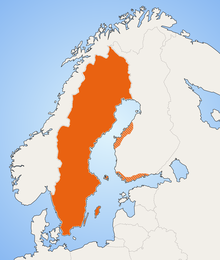Swedish-language
| Swedish | |
|---|---|
| svenska | |
| Pronunciation | [²svɛnːska] |
| Native to | Sweden, Finland, Estonia |
| Ethnicity | Swedes, Finland Swedes, Estonian Swedes |
|
Native speakers
|
9.2 million (2012) |
|
Indo-European
|
|
|
Early forms
|
|
|
Latin (Swedish alphabet) Swedish Braille |
|
| Tecknad svenska (falling out of use) | |
| Official status | |
|
Official language in
|
2 countries 2 organizations |
| Regulated by |
Swedish Language Council (in Sweden) Swedish Academy (in Sweden) Research Institute for the Languages of Finland (in Finland) |
| Language codes | |
| ISO 639-1 | sv |
| ISO 639-2 | |
| ISO 639-3 | |
| Glottolog | swed1254 |
| Linguasphere | 52-AAA-ck to -cw |

Major Swedish-speaking areas
|
|
Swedish (![]() svenska [²svɛnːska]) is a North Germanic language, spoken natively by more than 9 million people predominantly in Sweden and parts of Finland, where it has equal legal standing with Finnish. It is largely mutually intelligible with Norwegian and Danish. Along with the other North Germanic languages, Swedish is a descendant of Old Norse, the common language of the Germanic peoples living in Scandinavia during the Viking Era. It is currently the largest of the North Germanic languages by number of speakers.
svenska [²svɛnːska]) is a North Germanic language, spoken natively by more than 9 million people predominantly in Sweden and parts of Finland, where it has equal legal standing with Finnish. It is largely mutually intelligible with Norwegian and Danish. Along with the other North Germanic languages, Swedish is a descendant of Old Norse, the common language of the Germanic peoples living in Scandinavia during the Viking Era. It is currently the largest of the North Germanic languages by number of speakers.
Standard Swedish, spoken by most Swedes, is the national language that evolved from the Central Swedish dialects in the 19th century and was well established by the beginning of the 20th century. While distinct regional varieties descended from the older rural dialects still exist, the spoken and written language is uniform and standardized.
The standard word order is, as in most Germanic languages, V2, which means that the finite verb appears in second position of a declarative main clause. Swedish morphology is similar to English; that is, words have comparatively few inflections. There are two genders, no grammatical cases (except for pronouns), and a distinction between plural and singular. Older analyses posit the cases nominative and genitive and there are some remains of distinct accusative and dative forms as well. Adjectives are compared as in English, and are also inflected according to gender, number and definiteness. The definiteness of nouns is marked primarily through suffixes (endings), complemented with separate definite and indefinite articles. The prosody features both stress and in most dialects tonal qualities. The language has a comparatively large vowel inventory. Swedish is also notable for the voiceless dorso-palatal velar fricative, a highly variable consonant phoneme.
...
Wikipedia
